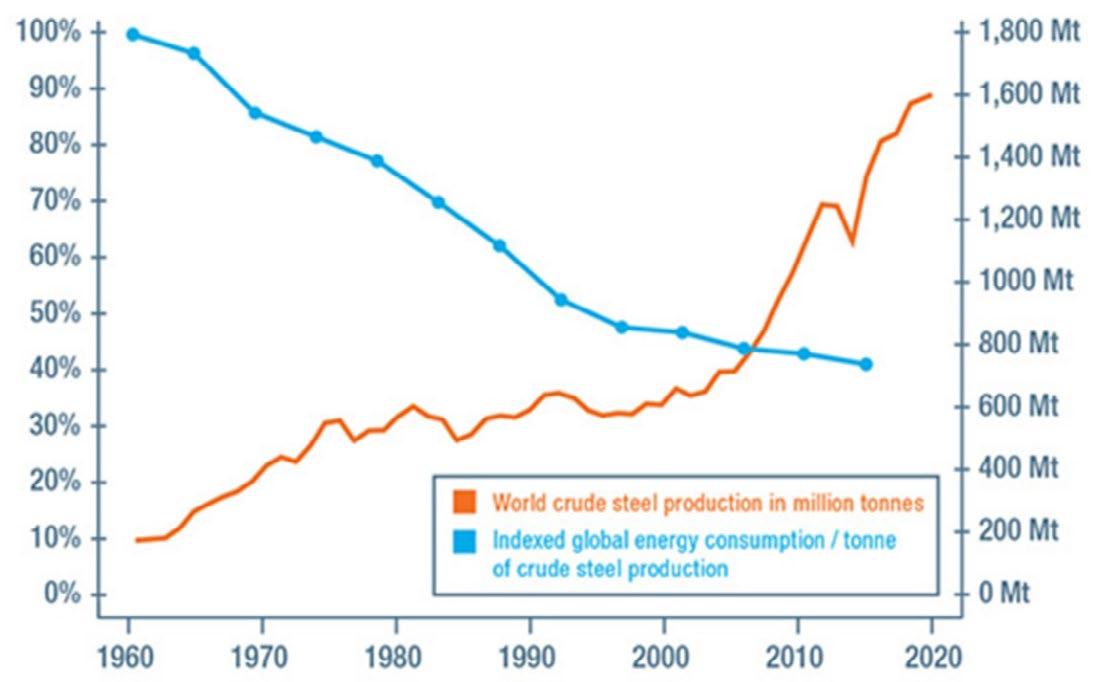
14 minute read
edited by : M. Ometto, C. Ponton, D. Armellini..................................................................................... pag
Q-SYM2 and Automatic Scrap Classification
a joint solution for the Circular economy and sustainability of Steel Manufacturing, to ensure the scrap yard operates competitively
edited by: M. Ometto, C. Ponton, D. Armellini
A hype topic, one that now has become an established idea, is the possibility to increase plant efficiency by gaining and applying a better awareness of how scrap is performing in the melting process. Scrap management becomes the key point in cost reduction since it could comprise up to the 50% of the overall production costs. Technological innovations promise to be the driver to improving raw material management, shortening its acquisition time and reducing the waste during the metallurgical process. Expensive raw materials require a huge involvement of plant resources, and are highly dependent on the human factor. All the quality and logistics decisions belong to the judgment of the operators, increasing the chance of nonconformities (e.g., erroneous classification, material discharged in the wrong location, error loading material in the buckets). To overcome these issues, online classification of the scrap is the keystone. Starting from the arrival of scrap at the plant, through the acceptance of the delivery note and the check-in of the carriers, Automatic Scrap Classification gives support to inbound-scrap control and classification, enabling real-time traceability of the scrap inside the bays. The Quality Control System will benefit from all the details of the material used in production. Danieli Automation, with its Digi&Met business unit, implemented the Q-ASC a system that, leveraging Artificial Intelligence (AI) and deep learning techniques, can assist scrap classification procedures through computer vision and automatic scrap recognition. The goal of scrap identification is to localize and assign a specific class label to a given visual sample of scrap or inert/hazardous material. The classification can be conducted using different methodologies based on material shapes or dimensions. Danieli Automation Q-ASC is the entry point for the Scrap Yard Management and can be considered as the central data hub for managing the scrap inbound to the plant, connecting all the systems requiring reliable scrap data such as ERP, MES, WMS, and the Process Control and Quality Control Systems. Q-ASC collects, consolidates and transforms data, in the form of pictures, into information for scrap classification.
STEEL INDUSTRY AND CIRCULAR ECONOMY This article describes the optimisation of the scrap lifecycle in steel manufacturing, especially in the decarbonisation of steel manufacturing. The scrap cycle is a paradigmatic demonstration of the importance of changing the business model from Linear to Circular Economy. To achieve this, it is necessary to rethink and reshape the technological approach, exploiting the great potential contribution to reduce CO2 emissions and waste quantities. In this sense, it is important to analyse the case study of scrap use in steel manufacturing. Marco Ometto, Cristiano Ponton, Davide Armellini
Digi&Met direction business unit, Danieli Automation S.p.a m.ometto@dca.it / c.ponton@dca.it / d.armellini@dca.it
Fig.1 - Crude steel production and specific CO2 emissions compared to 1960 (=100). Source WSA [1]
Considering that the steel is a ‘permanent’ material, 100% recyclable (champion of performance/OpEx), thanks to its ability to maintain unique properties when properly processed, and the increased results obtained since the 1960s in terms of steel production vs energy consumption (Fig.1 - a typical indicator of environmental efficiency), the EU decided to introduce carbon reduction as hype topic – and set this as a mandatory goal for steelmakers to accomplish. Targeting Carbon Neutral by 2050, with the intermediate target of a 45% reduction by 2030, this now represents a change in the priorities of Climate Change, and it has practical implications on the steel sector concerning both for manufacturing and usage. In this challenging context, the transition from the Linear Economy to the Circular Economy (Fig.2) plays a big role in the progress toward carbon neutrality. In terms of definitions and differences, the Linear Economy model follows the “take-make-dispose”, step-by-step approach: raw materials are collected, transformed into products, used in the market, and finally discarded as waste. The added value is created, in this economic system, by producing and selling as many products as possible [1]. Instead, the Circular Economy paradigm follows the 4R approach: “reduce-reuse-recycle-remanufacture”. To clarify: the resources and waste production are minimised; reuse of products is maximised; recycling of raw materials and material with higher quality standards, no longer usable in the normal process, are maximised; and the old products are directly remanufactured. Moreover, circularity implies that materials are reused as much as possible.
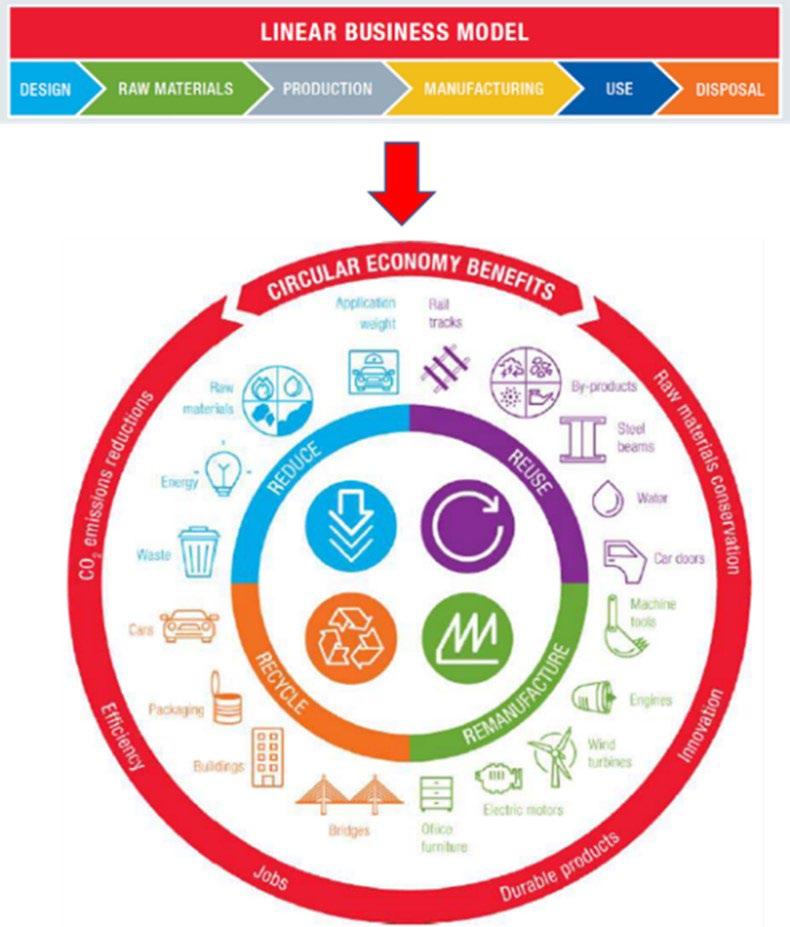
The integration of the scrap cycle as key step for efficiency and reduction of environmental footprint The paradigm changes in the steel manufacturing business, to comply with the achievement of Carbon Neutrality by 2050, will be a long-term process requiring sizable economic efforts to exploit consistent effects, to realize Sustainable Steel Manufacturing1 . To analyse issues and consequences with practical cases, the use-case of the scrap cycle within the EAF route is considered. The optimisation of the scrap cycle management is the key point for the future steelmaking industry to implement the process toward decarbonisation. As a premise, the EAF route is highly relevant to this process [2], [3] due to the fact that the volume of steel produced by EAFs and the associated scrap demand will increase substantially in the coming years (see Table 1 on the impact of 1 ton of scrap in terms of savings) and initiating further actions in all of the chain’s steps.
Tab.1 - Savings for each ton of remanufactured scrap comparing between EAF and BF/BOF routes.
Source: Siderweb Research Department

To do that, the European Commission refers to “twin green and digital transitions or also called Twin Transition” [4], pointing to the digital and climatic transitions as pre-requisites to be achieved. As a consequence, it becomes necessary to exploit the expected benefits of integrating a seamless scrap process. An example of how such integration can be realized to provide consistent benefits through the implementation is the “smartisation” of the scrap cycle. The integration will involve embedding intelligent applications based on Artificial Intelligence techniques and mathematical models. For these reasons, the integrated approach provided by the Q-SYM2 suite software will be used as a practical guideline to show how seamless integration of the scrap cycle can be carried out proficiently to address the main topics of integration and smartisation, exploiting the expected benefits and solving the main issues of this challenge. As a conceptual map of the approach, consider Fig. 3.
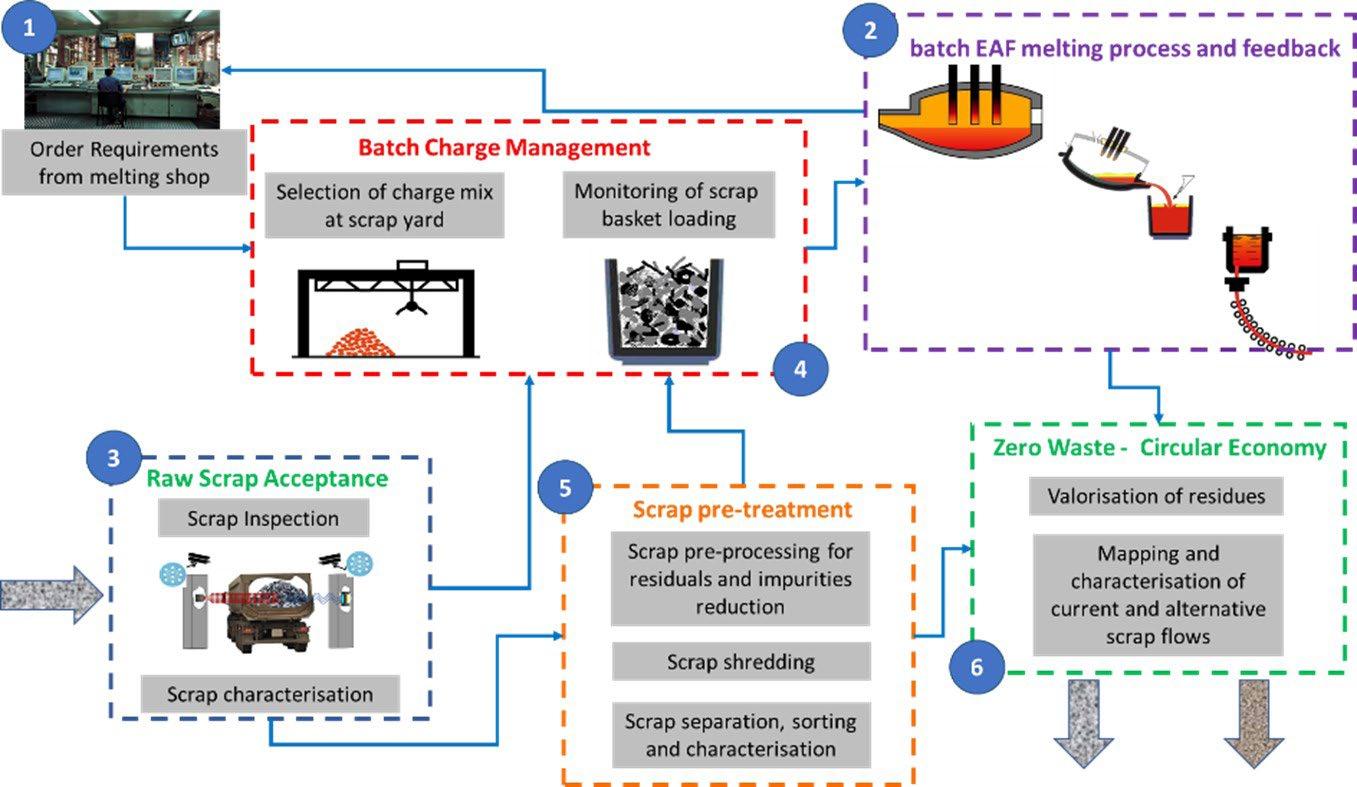
Fig.3 - The scrap cycle within the steelmaking plant.
1Sustainability is defined according to its three pillars: “Prosperity, Planet and People.” Prosperity is intended as the economic value added for the satisfaction of steel stakeholders and shareholders; Planet is intended as the reduction of the environmental footprint, such as reduction of CO2 emissions, optimal use of resources etc.; People as the impact on social issues, such as health and safety, diffused improvement of life quality for the workers and neighbouring community, creation of workplaces, increase in training people for new or improved skills, etc.
Issues, benefits and approach of the integrated scrap chain: Q-SYM2 as an integrated system for Smart Scrap Cycle Management. The scrap cycle is inherently circular. In this context, Q-SYM2 is an example of an efficient and effective tool for optimising scrap management, developed by the Danieli Automation company. The system has been designed by a group of analysts, experts in steel manufacturing, with the direct involvement of scrap suppliers and steelmakers (part of the Danieli Holding) and the cooperation of selected Danieli customers to address objectives, needs and priorities. The target stakeholders in this process are: 1. scrap suppliers running the part of the scrap supply chain from preliminary classification to the discharge of trucks and rail cars to steel plants (revised block 3 and as-it-is block 5). 2. steelmakers running the scrap cycle internally (at least block 3 and block 5; block 6 might not be included in the value chain and left to third parties). The digitalisation of steel manufacturing is a step-bystep process. Some considerations will be made in the following regarding the key steps for system implementation with the aim of optimising operations in order to provide the best scrap charge to the EAF.
Step1: The key objective of the seamless integration and smartisation of the scrap cycle The main objective of the seamless integration and smartisation of the scrap cycle consists of providing the furnace with the best classified raw material, processed upstream by equipment or machinery so as to improve the transformation costs in the melting process. From the functional point of view the integration does not consider, in this discussion, the direct in-line access to the purchasing process and the possibility of sharing timely data to improve management performances. Instead, checking the information from and to the purchasing process and, in general, between the scrap management system and the Enterprise Resource System (ERP), opens the possibility of extending the vision of the smart system to a set of new functions. The full integration of meltshop and machinery and the efficient data flow is the basic pillar of the integrated intelligent system necessary to achieve smart management of scrap. Q-SYM2 is based on a set of new technologies as intelligent vision, AI-based software and optimisation modules that efficiently support the decision makers in each step, from the characterisation phase to the optimisation of the furnace loading. The customisable HMI and process monitoring features provide real-time suggestions on the optimal resolution of the main operational issues.
Step 2: Check of the ICT infrastructures A crucial aspect in the conceptual design of the integration process is realized by a consistent data flow among different equipment, sensors and systems, to plan and execute operations as fast as possible. Planning, scheduling and supervision of operations need reliable links with upward, if any, and downward manufacturing areas. It is well known that the efficiency of the scrap process is directly affected by the level and performances of the ICT infrastructure. So, a first step for checking the ICT landscape of companies is required to get the maximum level of expected performances and benefits. The optimal scrap management needs a continuous exchange of information with the inventory, the purchasing process and the Enterprise Resource Management (ERP), as shown by the aside Fig. 4. Furthermore, a proper IT infrastructure influences the performance, providing real-time data to the final end-users, reducing manual data entry, and creating an historical knowledge base for analysis.
Fig.4 - Q-SYM2: the seamless integration of functions in the scrap chain and connections to key functions and systems.
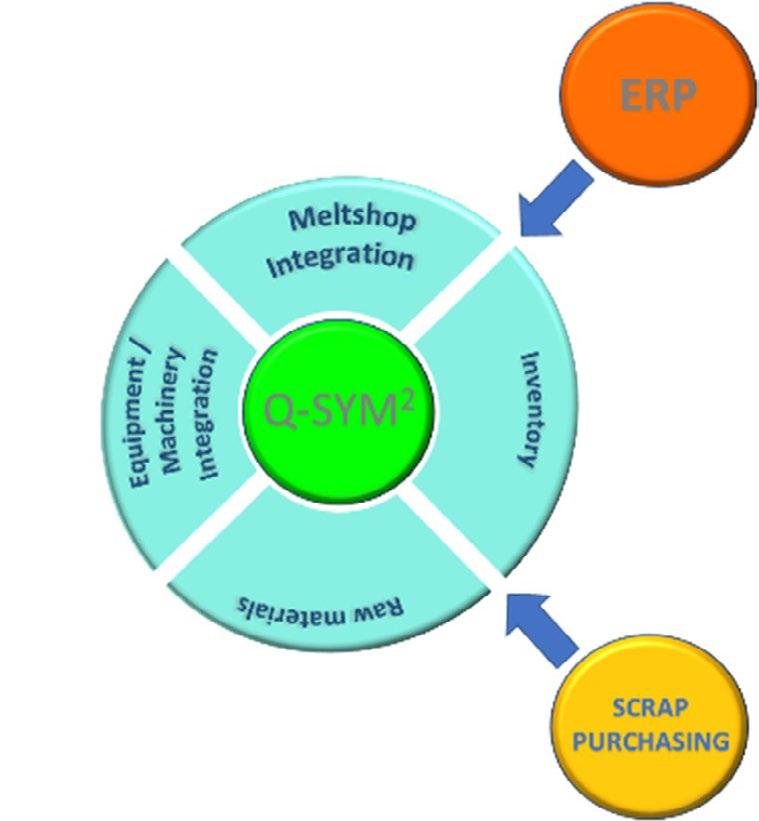
On these considerations, Q-SYM2 has been developed by looking particularly at the interoperability and the easy integration with legacy and new systems. Another main aspect of Q-SYM2 is its modularity, to allow its evolution in time with the implementation of basic and advanced functionalities according to the available investment and the technology maturity.
Step 3: Progressive implementation and evolution of the Intelligent Scrap Yard Management. The achieved versus expected benefits are the key factor to decide how to evolve the system with additional trainings of the AI models, or with new investments in technologies to improve the efficiency of the scrap yard. To measure performances and efficiency to improve operational and organizational procedures, a continuous improvement approach is required. The “management-by-KPIs” approach is supported by a dedicated BI module that gives insights on the measures, the possible areas of improvement, and the actions required to achieve it. Table 2 gives a view at a glance of such expectations and the directions of the possible improvements. For both basic and advanced functions, the set of benefits and correlated KPIs to measure them are listed. To a certain extent, this is a segment of the process monitoring up to the melting process.
Tab.2 - Basic and extended benefits of Intelligent Scrap Yard Management and relevant KPIs.
ICT evolution impact on scrap management systems. Considering the exponential evolution of the ICT systems of the last decade, which likely will continue in the immediate future, it is essential to have the possibility of evolving the systems with additional modules. Q-SYM2 is a Smart System implemented with a modular design that allows it to grow it in an easy way, implementing at the time additional modules and associated functions. Being part of an extendable suite, with the possibility of customization, Q-SYM2 makes it possible to comply with ICT and technological evolution to adopt new, standardized connection protocols or new, emerging technologies for scrap management. A view of the complete Q-SYM2 suite, comprised of Core and Advanced Modules, is given in Fig. 5. This provides a functional description based on the six clusters and, for each of them, the relevant basic and advanced modules. For example, the MELTSHOP INTEGRATION cluster shows the basic module “FURNACE MONITORING” with the three advanced modules dealing with scrap processing, equipment instructions and monitoring of the charge mix. Charge Mix Monitoring is carried out closing the loop between the best approximation of the scrap charge, the already loaded scrap and the melting process evolution. The charge
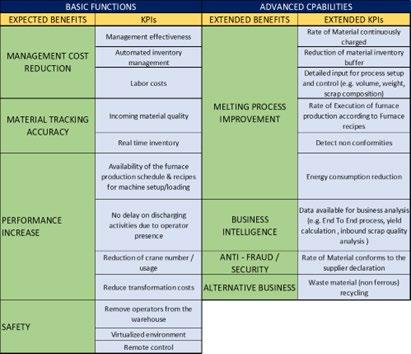
management is done in the cluster Track; the loop consists of the real time tracking of the available scrap in the yard, the data received through the machine sensors during the process and the furnace requirements in terms of melting recipes.

Fig.5 - Functional Clusters, Core and Advanced Modules.
The system architecture based on micro services represents the best solution to make updatable software according to new functions and the evolution of ICT. This is a noticeable feature of Q-SYM2 . ICT new technologies contribute to the possibility to include architectural enhancements such as IoT, Cloud and Edge Computing. In particular IoT, when the exchange of the secured data is integrated, can lead to further increase in terms of flexibility, interoperability and connectivity. From the point of view of new features according to new needs, the CAPEX (and then OpEx) of the system can be a limitation. However, knowing exactly the complexity of the problem and the goals to be achieved, it leads to a system designed to be flexible in use and modular in CAPEX.
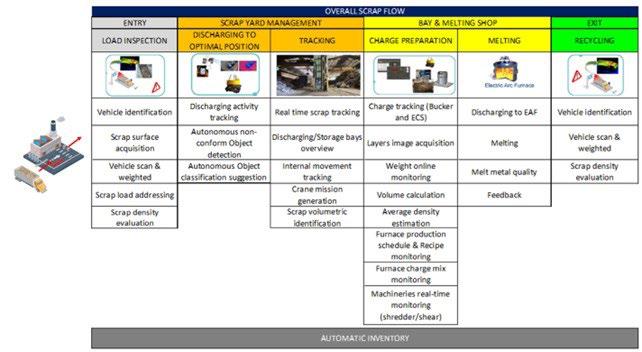
Each module performing specific actions, as listed above, is connected to the nearest modules with an already mentioned seamless connection. Coupled with Fig.6, the data flow must follow the operational logic into the often-mentioned seamless chain (see Fig.7).
Fig.7 - Logic flow of scrap operations. Data flow mirrors the operational flow.
Automatic scrap classification: a centralized datahub to ensure the scrap yard competitiveness The Q-SYM2 smart system implements the emerging ICT technologies, leveraging the application of the AI (Artificial Intelligence) along with the deep learning techniques, to overcome the issues on the scrap classification, nowadays highly depended on the human factor. The Q-SYM2, with the advanced module called Q-ASC, supports the online scrap classification through computer vision and automatic scrap recognition. Starting at the arrival of the scrap at the plant, through the acceptance of the delivery note and the carriers check-in, the Automatic Scrap Classification gives support to the scrap inbound control and classification enabling a real-time traceability of the scrap inside the bays. The goal of scrap identification is to localize and assign a specific class to the different areas of a load or to automatically detect the presence of inert/hazardous material. The classification can be conducted using different methodologies based on material shapes, dimensions and other visual characteristics. The analysis and the material recognition, executed by the system, is conducted on the images acquired by fixed cameras or mobile devices. Q-ASC is driven by the key factors of higher efficiency, higher reliability, higher safety and lower OpEx of the scrap yard.
Fig.8 - Comparison between original scrap acquisition and detected ones.


CONCLUSIONS The context and trends to automatise the scrap management with an integrated seamless flow of operational data has been presented using the up-to-date software package Q-SYM2 developed by the DIGI&MET Division of the Danieli Automation Company part of the Danieli Group. Q-SYM2 aims at providing the best scrap charge to the EAF. Therefore, the approach based on large use of AI, Deep and Machine Learning has been applied to provide both the self-learning capabilities and the tailored optimisation of operations, considering the scrap characteristics dynamics. This is a consequence of the inherent Circularity of scrap inside the steel sector, with still a large potential of contributing to the reduction of the environmental footprint. Based on such premises, the needs coming directly by the steelmakers and the scrap suppliers have been considered as the main requirements for developing a modular and interoperable system, fully compliant with the Industry 4.0 paradigm. In this sense, the strong connection among operational logic, ICT architecture and potentials, and functionalities have been discussed. Credible and provable benefits with its relevant KPIs, both in the systems implementation and operational and monitoring phases, had been analysed. Saying that, the relevant dataflow must mirror the scrap flow for optimising operations with the aim to decrease OpEx, that it is still a complex issue, but with further room for implementation.
BIBLIOGRAPHY
[1] Steel in the circular economy, © World Steel Association 2015, ISBN 978-2-930069-80-7 [1] ESTEP AISBL, [2] Brussels, The Clean Steel Roadmap, November 17, 2020, https://www.estep.eu/assets/Uploads/20210106-CSP-Roadmap-afterPublicConsultation2.pdf [3] Green steel by EAF route: a sustainable value chain in the EU Circular Economy scenario, WORKSHOP REPORT, Bergamo, Nov 2019, ESTEP AISBL, E.Malfa et al., January 2020, https://www.estep.eu/assets/Uploads/20191129-WorkshopReport-ESTEP-EAFGreenSteelFinalDraft.pdf [4] ENVIRONMENT, Eco-innovation Action Plan, https://ec.europa.eu/environment/ecoap/about-eco-innovation/policies-matters/ green-and-digital-twin-transition-also-spurs-inclusive-eco_en







